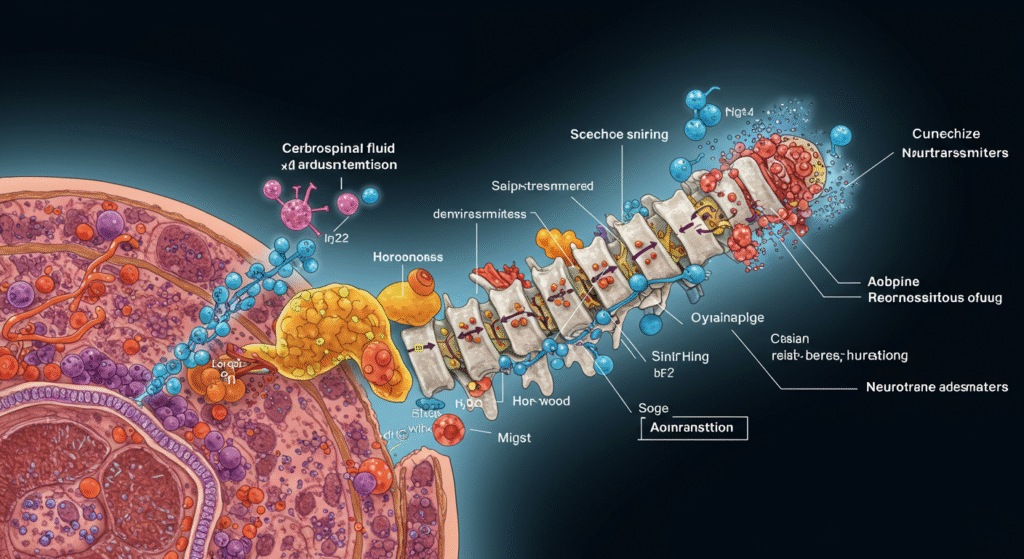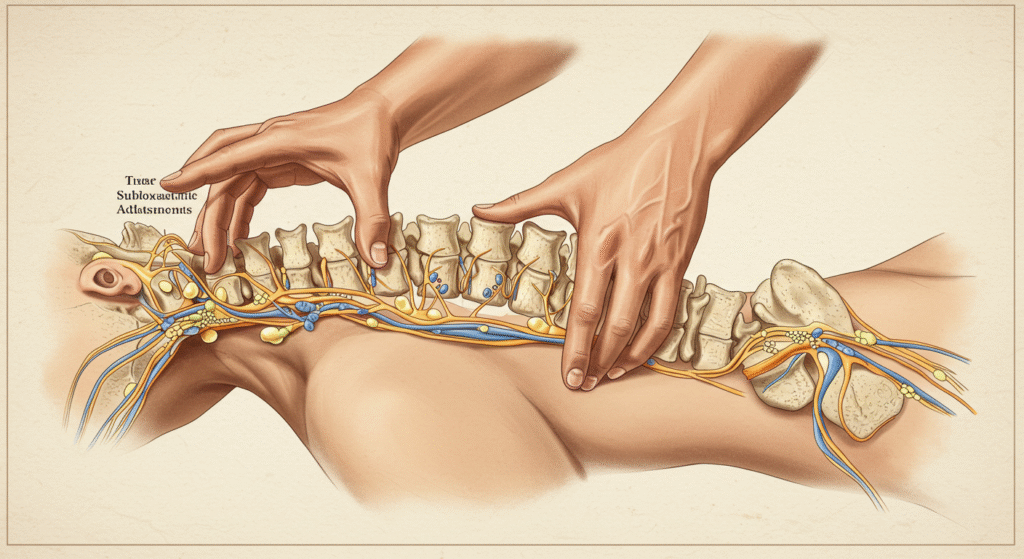If you’ve ever visited a chiropractor, you may have noticed feeling better initially, but then experiencing unexpected symptoms such as fatigue, muscle soreness, or flu-like feelings. Many people wonder if these effects are caused by “toxins” being released from the body. But what does this really mean?
In this guide, we will uncover the truth about toxin release following chiropractic adjustments. We’ll discuss what substances might be involved, why these symptoms occur, and how to handle them. Whether you’re new to chiropractic care or have been receiving treatments for a while, understanding the effects after adjustments can help you make the most of your sessions and reduce any discomfort.
Chiropractic care is more popular than ever in 2025, and it’s important to understand how the body reacts to these treatments. Let’s explore what happens during and after a chiropractic adjustment.
What Is a Chiropractic Adjustment?

A chiropractic adjustment is a controlled, quick force applied to a spinal joint to correct misalignments or subluxations. Chiropractors use various techniques, each with a slightly different approach to spinal manipulation.
How It Works:
The aim of an adjustment is to realign the vertebrae, improving nerve function, blood flow, and supporting the body’s natural healing abilities. This realignment may also aid lymphatic drainage, helping to eliminate waste from the body.
Common Techniques:
- High-Velocity Low-Amplitude (HVLA): The “pop” sound you hear during an adjustment occurs when a quick thrust is applied to the spine.
- Activator Method: A gentler technique using a handheld device to apply targeted force.
- Gonstead Technique: Focuses on specific spinal segments for precise adjustments.
- Spinal Decompression: A traction table gently stretches the spine to relieve pressure.
Benefits of Chiropractic Adjustments:
- Pain relief
- Enhanced mobility
- Reduced inflammation
- Support for detoxification via improved circulation and lymphatic flow
What Does “Toxin Release” Mean in Chiropractic Care?

What Are Toxins?
In chiropractic, “toxins” typically refer to harmful substances, both external (like environmental pollutants) and internal (such as metabolic waste). These toxins accumulate over time and may interfere with normal body functions.
Do Chiropractic Adjustments Release Toxins?
Chiropractic adjustments don’t directly release toxins into the body. Instead, they help move metabolic byproducts, like lactic acid, cortisol, and other inflammatory substances, which accumulate in muscles and tissues.
Why the Confusion?
The symptoms people experience after an adjustment—such as fatigue, soreness, and discomfort—are often mistaken for toxins being released. These effects actually stem from changes in the nervous system, muscle relaxation, and the body’s natural healing process. The belief that toxins are released is likely due to the combination of these factors and the physical sensations patients feel.
Recent studies (2024-2025) focus on metabolic byproducts like lactic acid and cortisol in post-adjustment symptoms, rather than external toxins.
What Substances Are Mobilized After an Adjustment?

During and after a chiropractic adjustment, various substances are released in the body. These can range from metabolic byproducts to helpful compounds that aid in healing.
Metabolic Byproducts:
- Lactic Acid: A byproduct of muscle activity, especially when muscles are tense. As muscles relax after an adjustment, lactic acid is released, which can cause temporary soreness.
- Carbon Dioxide: The “popping” sound heard during adjustments happens when gas bubbles in joint fluid collapse, releasing carbon dioxide.
- Prostaglandins and Histamine: These inflammatory compounds regulate healing but may cause mild discomfort as tissues relax and blood flow increases.
- Cortisol: A stress hormone released during adjustments, which can temporarily affect mood and energy.
Environmental Toxins (Rare):
Chiropractic care may indirectly assist in mobilizing environmental toxins like mercury or lead through improved circulation. However, this is not a primary reason for chiropractic visits.
Beneficial Compounds:
- Endorphins: These natural painkillers are released during adjustments, helping to reduce pain and improve mood.
Why Do You Feel Symptoms After an Adjustment?

Post-adjustment symptoms are usually part of the body’s healing process. These effects may vary from mild to moderate and typically last for 24 to 48 hours.
Retracing Phenomenon:
Sometimes, older symptoms resurface briefly as the body heals, a process known as “retracing.” This indicates that the body is addressing past injuries, not releasing toxins.
Common Symptoms (affecting ~20% of patients):
- Fatigue: Increased metabolic activity can cause temporary tiredness.
- Muscle Soreness: Lactic acid and other byproducts are released as muscles relax, leading to temporary soreness.
- Headaches: Caused by the body processing metabolic waste or adjustments affecting the nervous system.
- Flu-like Symptoms: Mild fever, nausea, or grogginess may occur due to inflammation as the body repairs itself.
- Emotional Changes: Shifts in cortisol and endorphin levels can cause temporary emotional fluctuations.
Duration of Symptoms:
These symptoms typically last 24 to 48 hours, but can occasionally last up to a week. If symptoms persist beyond that, consult with your chiropractor to rule out other issues.
When to Seek Help:
If symptoms persist for more than 3 days, it’s advisable to consult with your chiropractor or healthcare provider.
The Science Behind Post-Adjustment Effects

Nervous System Response:
Chiropractic adjustments remove subluxations—misalignments in the spine that interfere with nerve communication. This can lead to energy surges, resulting in temporary discomfort or tiredness.
Lymphatic and Circulatory Boost:
Chiropractic adjustments promote better blood flow and lymphatic drainage, which helps the body expel metabolic waste more efficiently. The increase in circulation can cause temporary discomfort as the body processes these waste products.
Inflammatory Response:
Mild inflammation is part of the healing process and can lead to temporary symptoms like soreness, fatigue, or headaches.
Research Insights (2024–2025):
Recent studies show that chiropractic care improves circulation and lowers cortisol levels, aiding stress reduction and recovery. However, no conclusive evidence links chiropractic adjustments directly to the release of environmental toxins.
How to Support Your Body After a Chiropractic Adjustment
To manage post-adjustment symptoms and support the healing process, consider these tips:
- Hydrate: Drink 8–12 glasses of water daily to help flush out metabolic waste.
- Eat Well: A diet rich in antioxidants (e.g., leafy greens, berries, nuts) supports detoxification.
- Rest: Get 7–8 hours of sleep per night to help the nervous system recover.
- Exercise Lightly: Activities like yoga, stretching, or walking can enhance circulation without overstraining your body.
- Supplements: Consult a healthcare professional about supplements like milk thistle or dandelion root for liver health.
- Relaxation: Techniques like meditation or deep breathing help reduce cortisol and stress.
Comparing Chiropractic Adjustments to Other Therapies
When considering pain relief and detox options, chiropractic care stands out for its focus on spinal health and the nervous system. Here’s how it compares to other therapies:
| Therapy | Focus | Detoxification Support | Pain Relief |
|---|---|---|---|
| Chiropractic | Spinal realignment, nerve function | Enhances circulation and lymphatic drainage | Reduces nerve interference and muscle tension |
| Massage Therapy | Muscle relaxation, circulation | Releases lactic acid | Eases muscle tension and soreness |
| Physical Therapy | Rehabilitation, mobility improvement | Limited detox focus | Targets specific areas of pain and mobility |
| Acupuncture | Balances energy flow | Promotes overall wellness | Relieves muscle and joint pain |
FAQs About Chiropractic Adjustments and Toxin Release
Do all adjustments release toxins?
No, chiropractic adjustments are focused on spinal health rather than detoxifying external toxins.
Are symptoms after an adjustment normal?
Yes, mild symptoms like fatigue and soreness are common and generally resolve within a few days.
Can chiropractic detox my body?
While chiropractic care supports natural detoxification processes, it isn’t a primary method for detoxifying the body.
How often should I get adjusted?
Frequency depends on your specific health needs. Your chiropractor will help you develop a personalized treatment plan.
Expert Insights: What Chiropractors Say in 2025
As chiropractic care becomes more popular, experts are adopting a holistic approach to wellness, often combining spinal adjustments with nutrition, stress management, and lifestyle changes to improve overall health.
Recent Trends:
Chiropractors are increasingly focusing on the connection between the nervous system, immune function, and detoxification.
Conclusion
While chiropractic adjustments don’t directly release toxins, they do help mobilize metabolic byproducts like lactic acid and cortisol, which can lead to temporary symptoms. Understanding these post-adjustment effects can help you manage discomfort and fully benefit from chiropractic care.
Ready to experience chiropractic care? Schedule a consultation with a licensed chiropractor today to begin your path to better health.
Dr. Joe R. Witt is a licensed chiropractor with over 12 years of experience in spinal health and holistic wellness. Holding a Doctor of Chiropractic degree and a Master’s in Human Nutrition, Dr. Witt specializes in understanding the physiological effects of chiropractic adjustments, including post-adjustment symptoms and detoxification processes. He has authored numerous articles on chiropractic care, focusing on evidence-based practices and patient education. Based in [Your City], Dr. Witt runs a thriving practice where he empowers patients to achieve optimal health through personalized spinal care and lifestyle strategies. His expertise has been featured in wellness blogs and chiropractic journals, making him a trusted voice in the field.

